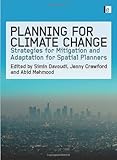| Title: | Planning for Climate Change: Strategies for Mitigation and Adaptation for Spatial Planners |
| Categories: | Construction |
| ISBN-10(13): | 1844076628 |
| Publisher: | Routledge |
| Publication date: | 2009-08-21 |
| Number of pages: | 344 |
| Language: | English |
| Picture: |

|
| Review: |
The sub-title of this book is 'Strategies for Mitigation and Adaptation for Spatial Planners'. The book is essentially targeted on planners it but should be of interest to wider communities in the construction industry including architects and developers. This is an edited work with contributions from 36 authors, it has 23 chapters structured into 3 sections. With so many authors representing a wide range of expertise drawn from Universities and Government and other agencies this can be regarded as a well informed text carrying some authority. Part 1 addresses the challenge of climate change and does so in respect of spatial planning, and of development patterns to both mitigate and adapt to global warming. This section goes on to explore: transport policies; and transport planning drawing on US and Australian cities. The vulnerability that climate change causes threatening poverty alleviation in developing countries and the planning challenges of small islands are also addressed. Part 2 examines the strategic planning responses. Those scrutinised include: The European Union's progress for mitigation and adaptation; California's policy innovation and structural hurdles; Australia's urban resilience and the limits of ecological modernisation; Canada's new-growth management experiments; Wind energy in Northern Europe; Sustainable construction in UK planning; The Netherlands spatial planning and water management; and Flood risk methodologies in the UK. Part 3 deals with implementation, governance and engagement and covers: Use of scenarios for climate change adaptation in spatial planning; Support for regional and local decision making; Planning for green infrastructure; Swedish municipal responses; Moving cities towards a low carbon sustainable future; Planning and governance; and finally Public engagement. The big issues that emerge in this book are 'mitigation' and 'adaptation', 'urban and development patterns' and 'vulnerability to climate change'. The balance between these issues is where the difficult decisions that affect planners lies and this book gives some insight to these delicately balanced decisions. I found the international coverage of the topics particularly interesting and stimulating, global warming is a global problem requiring global action and the UN's Copenhagen conference is evidence of the drive towards solutions. This book will be, of course, great interest to planners but there are many others in our construction industry that need to be involved especially those that influence policy formulation in response to climate change and those who may think that they are simply developing our built environment but are, in fact, involved in these larger problems that face the planet. Ronald McCaffer December 2009 |



